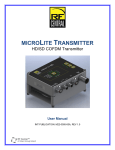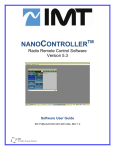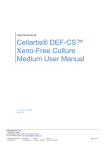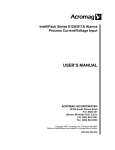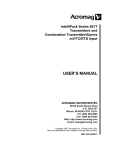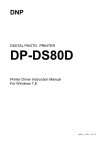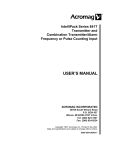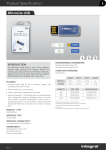Download MicroLite Receiver Manual
Transcript
MICROLITE RECEIVER HD/SD COFDM Dual Diversity Receiver User Manual IMT PUBLICATION: M23-0005-00A, REV 1.1 MicroLite Receiver User Manual Revision History Date May 16, 2011June 13, 2011 August 8th. 2011 October 12, 2011 11/05/2011 Revision 0.1D 0.2D (BETA) .3D Modified by Dave Anderson (Mike Hardy) Mike Hardy Mike Hardy Sean Van 11/27/2011 .4D Sean Van 01/05/2011 .5D Sean Van 01/23/2011 – 02/06/12 .6D Sean Van 02/07/2012 1.0 Sean Van 02/14/2012 1.1 Sean Van 0.0D Description Initial Writing Ongoing updates and clarifications Clarified future dual-band option Added Theory of Operation and Description Added Formats, formatting, and Specifications Updated FCC and CE Updated, added up to date drawings, updated specifications and formatting. Updated operational data. Review and Initial Release Changed Chapter 4 to Installation and Operation. Added Figure 4.1 MicroLite Receiver User Manual Publication: M23-0005-00A IMT, LLC. 200 International Drive Mt. Olive, NJ, 07828, USA. T +1 908 852 3700 F +1 908 813 0399 www.imt-solutions.com Revision 1.1 2 MicroLite Receiver User Manual We make every effort to ensure our documentation is as accurate and as complete as possible. In the event that you find any errors or omissions, please contact Customer Tech Support at (908) 852-3700, or via email at [email protected]. © Copyrighted 2012 - IMT, LLC - Mount Olive, New Jersey 07828 NOTICE This device complies with part 15 of the FCC Rules. Operation is subject to the following two conditions: (1) This device may not cause harmful interference, and (2) this device must accept any interference received, including interference that may cause undesired operation.” Revision 1.1 3 MicroLite Receiver User Manual microLite Receiver User Manual Contents 1 Introduction ___________________________________________________________________ 7 1.1 2 Manual Overview _________________________________________________________________ 7 MICROLITE Description ____________________________________________________________ 9 2.1 microLite Features and Benefits _____________________________________________________ 9 2.2 Frequency Bands ________________________________________________________________ 11 2.3 microLite Receiver Theory of Operation ______________________________________________ 11 2.3.1 2.3.2 2.3.3 2.3.4 2.3.5 2.3.6 2.3.7 2.3.8 2.3.9 2.4 Dual Antenna Inputs _____________________________________________________________________ 12 Dual Microwave Receiver COFDM Demodulator Circuits ________________________________________ 12 Maximal-Ratio Combining Circuit __________________________________________________________ 12 MPEG4 Decoder ________________________________________________________________________ 13 Video Outputs __________________________________________________________________________ 13 Audio Outputs __________________________________________________________________________ 13 User Data Output _______________________________________________________________________ 13 Video over IP Encapsulation for Streaming Video ______________________________________________ 13 Faceplate Status Display and Preset User Interface ____________________________________________ 13 Remote Control and Firmware _____________________________________________________ 13 2.4.1 2.4.2 2.4.3 3 Remote Control via Ethernet ______________________________________________________________ 13 Remote Control via RS-232 _______________________________________________________________ 14 Firmware updates _______________________________________________________________________ 14 Specifications_________________________________________________________________ 16 3.1 Frequency Bands and RF Performance _______________________________________________ 16 3.2 Modulation Modes_______________________________________________________________ 16 3.3 Diversity _______________________________________________________________________ 16 3.4 MPEG 4 Decoder ________________________________________________________________ 16 3.4.1 3.4.2 Video _________________________________________________________________________________ 16 Audio _________________________________________________________________________________ 16 3.5 System ________________________________________________________________________ 17 3.6 Power Requirements _____________________________________________________________ 17 3.7 Environmental __________________________________________________________________ 17 3.7.1 3.7.2 3.7.3 3.8 4 Temperature Range _____________________________________________________________________ 17 Altitude _______________________________________________________________________________ 17 Physical Characteristics __________________________________________________________________ 17 User Interface and Remote Control__________________________________________________ 17 Installation __________________________________________________________________ 19 Revision 1.1 4 MicroLite Receiver User Manual 4.1 Overview ______________________________________________________________________ 19 4.2 Identifying MLR Physical Features and Interfaces ______________________________________ 19 4.3 Physical Installation ______________________________________________________________ 21 4.4 Connect External Signals __________________________________________________________ 22 4.4.1 4.4.2 4.4.3 4.4.4 4.5 5 Audio and Video ________________________________________________________________________ 22 Power ________________________________________________________________________________ 22 RS232 Control and User Data ______________________________________________________________ 22 ASI Out _______________________________________________________________________________ 22 Connect Antennas _______________________________________________________________ 23 Operation ___________________________________________________________________ 25 5.1 Power up the MicroLite Receiver ___________________________________________________ 25 5.2 Pre-Configure the MLR user options _________________________________________________ 25 5.3 Control and LED Interface _________________________________________________________ 25 5.3.1 5.3.2 Buttons: _______________________________________________________________________________ 26 Status Indicators: _______________________________________________________________________ 26 5.4 Using the MLR to Receive Audio and Video ___________________________________________ 26 5.5 Verify Operation_________________________________________________________________ 26 5.6 Streaming Video over IP/Ethernet __________________________________________________ 27 5.7 Using the MLR to Receive User Data _________________________________________________ 27 5.8 Maintenance Information _________________________________________________________ 27 Figures Figure 2-1: Internal Block Diagram __________________________________________________________________ 12 Figure 4-1: Output Connectors ______________________________________________________________________ 20 Figure 4-3: MLR Antenna Connectors _________________________________________________________________ 23 Figure 5-1: Front Panel Controls and Indicators ________________________________________________________ 25 Tables Table 2-1: MICROLITE RECEIVER - Summary of Features and Benefits ________________________________________ 10 Table 2-2: MLR Frequency Bands ____________________________________________________________________ 11 Table 4-1: Output Connectors _______________________________________________________________________ 20 Table 4-2: Remote Control / User Data Pinout __________________________________________________________ 22 Revision 1.1 5 MicroLite Receiver User Manual Chapter One 1 Introduction Revision 1.1 6 MicroLite Receiver User Manual 1 Introduction This document is a user manual for RF Central’s microLite Receiver [MLR]. The MLR is a compact, narrowband COFDM microware receiver that utilizes dual antenna diversity for robust, error free signal reception. The MLR is ideal for applications requiring a full featured high performance HD or SD receiver housed in a compact enclosure. ASI, HD-SDI, SD-SDI, Composite video, User Data and streaming video outputs are available from the MLR. The MLR uses industry standard output connectors for compatibility with a wide range of AV equipment. 1.1 Manual Overview Throughout this manual, the product is referred to as the “microLite”, the “microLite Receiver”, the “MLR”, “microLite RX”, or simply the “receiver.” The contents of this manual are as follows: Chapter 2 – Describes the features and theory of operation of the MLR receiver. Chapter 3 – Contains a list of product specifications. The specifications include the receiver’s frequency bands, channels, demodulator specifications, decoding specifications, size, power requirements, environmental specifications, and I/O specifications. Chapter 4 – Explains how to install the product. Chapter 5 – Describes operating procedures for the receiver using the push button user interface built into the unit. The rear of the manual contains warranty and repair information. Revision 1.1 7 MicroLite Receiver User Manual Chapter Two 2 Description Revision 1.1 8 MicroLite Receiver User Manual 2 MICROLITE Description This chapter describes the MLR features and theory of operation. It also includes a block diagram of the MLR and a description of the internal circuits. 2.1 microLite Features and Benefits Table 2-1 summarizes key features and benefits of the MLR. The microLite Receiver is a receiver that utilizes advanced silicon tuners and dual antenna inputs for robust, error free signal reception. The MLR can receive either HD or SD video transmissions using COFDM modulated microwave signals. The MLR uses maximal-ratio combining to take advantage of its dual antennas. The silicon tuners employed in the microLite Receiver includes low noise amplification, automated gain control, mixing, tuning, and demodulation functions on one integrated circuit. This facilitates low power, high performance, and space savings. The microLite Receiver contains a built-in, industry compliant, MPEG4 (H.264 part 10) decoder. The MLR can output ASI, HD-SDI, SD-SDI, or Composite video, as well as User Data. Stereo audio is included on the ASI and SDI outputs, and the MLR has left and right audio output jacks. The MLR features a 100 Mbps Ethernet LAN interface for streaming video over IP. This feature uses UDP/IP and allows received video to be viewed remotely using MPEG4 decoder software on a personal computer. A compatible MPEG4 decoder that runs on your remote host PC is required for this application. The top panel of the microLite Receiver has signal strength, status, and monitoring LEDs that provide useful information at a glance. The user interface also features a selector button for choosing between 16 pre-programmed configurations called “Presets”. Though the unit ships pre-configured, a graphical user interface that runs on a Windows PC is available to modify the operating parameters. IMT has the ability, should the need ever arise, to provide the user with firmware files and instructions for local firmware installation, such as for feature upgrades, etc. Revision 1.1 9 MicroLite Receiver User Manual Table 2-1: MICROLITE RECEIVER - Summary of Features and Benefits Feature Benefit COFDM facilitates high data rates and robust signal reception. Receives both high definition and standard definition video transmissions. Dual Antenna Diversity Using Best aspects of the transport stream received using either antenna is Maximal-Ratio Combining used, yielding robust, error free reception. MPEG4 (H.264 part 10) Industry standard video decoding. Video Decoder Integrated with IMT maximal-ratio combining scheme. ASI, HD-SDI or SD-SDI, and Compatible with industry standard A/V equipment. Composite Video Outputs SDI format switches automatically between HD and SD. An RS-232 data channel is received along with the program streams. User Data Channel Line audio outputs for connection to headphones, an amplifier, or Stereo Audio Line Outputs recorder. Audio is also available in ASI and SDI outputs. The MLR is pre-programmed for its operating environment using a Remote Control built-in web GUI via LAN or optional Remote Control Windows PC Via RS-232 Serial Interface GUI. Users can quickly select one of 16 pre-programmed preset Faceplate User Interface with configurations. This is through the programmable serial interface or Presets and Status LED’s by using the optional front panel user interface. Status and Alarm information is available at a glance. Integrated in small form factor. Rugged, Compact Housing COFDM HD and SD Microwave Receiver Revision 1.1 10 MicroLite Receiver User Manual 2.2 Frequency Bands The microLite Receiver is available in the following bands: Table 2-2: MLR Frequency Bands Base Part Number Frequency (GHz) 21MLR 23MLR 58MLR 2.025-2110 2.200-2.400 5700-6000 2.3 microLite Receiver Theory of Operation Major blocks in the MLR diagram include: Dual Antenna Inputs Dual Microwave Receiver and COFDM Demodulator Circuits Dual Input Maximal Ratio Combining Circuit MPEG4 Video Decoding Circuit Video Output Interfaces: ASI, SDI, and Composite Video Left and Right Audio Output Interfaces Preset Selection and Status Monitoring User Interface (Optional) Programmable Serial Interface and Internal Control CPU With Flash Memory Interface For Firmware Upgrades Power Circuitry Refer to Figure 2-1: Internal Block Diagram for following discussion. Revision 1.1 11 MicroLite Receiver User Manual Figure 2-1: Internal Block Diagram 2.3.1 Dual Antenna Inputs The MLR has two SMA antenna input connectors. The input impedance of the antenna connectors are 50 ohms. The frequency band supported by the antenna connectors are labeled next to the antenna inputs. 2.3.2 Dual Microwave Receiver COFDM Demodulator Circuits The MLR is capable of receiving COFDM transmissions from compatible products in multiple bands. The receiver standards supported by the MLR support high data rates with low error rates. Each antenna input is filtered and amplified by a low noise amplifier. The output of the amplifier is filtered again at the input of the RF receiver circuit. The receiver mixer down converts the received signals to the internal IF frequency. The COFDM demodulator is programmable to support transmission modes offering different data rates (Refer to Chapter 5 for more information). The output of the COFDM demodulator circuits contains transport streams carrying audio, video, and user data. 2.3.3 Maximal-Ratio Combining Circuit This feature enhances the robustness of the receiver when line of site obstructions occur in the transmission path. Revision 1.1 12 MicroLite Receiver User Manual 2.3.4 MPEG4 Decoder The MLR contains a built-in MPEG4 (H.264 part 10) compliant decoder. The decoder audio and video output is available on the SDI output jack. Both HD-SDI and SD-SDI are output on the SDI jack. 2.3.5 Video Outputs Video output jacks include: ASI – MPEG4 encoded transport stream SDI – HD-SDI and SD-SDI audio and video Composite Video – The MLR composite video output circuit automatically outputs either NTSC or PAL, per the user specified settings. 2.3.6 Audio Outputs The MLR has left and right audio line output jacks. Stereo audio is also part of the ASI and SDI video outputs. The Audio output jacks are 75 Ohm RCA connectors. 2.3.7 User Data Output A data channel is transmitted with the audio and video information. Access of the data channel is through the RS-232 serial interface output connector. The baud rate and other RS-232 parameters are programmable. 2.3.8 Video over IP Encapsulation for Streaming Video The MLR features a 100 Mbps Ethernet LAN interface for streaming video over IP. This feature allows received video to be viewed remotely using MPEG4 decoder software on a personal computer. 2.3.9 Faceplate Status Display and Preset User Interface If you commonly use several configurations in the field, the faceplate LED preset settings and “Set” selector button provide a quick way to change pre-programmed configurations. Status information is also presented by LED’s. Refer to Chapter 5 for more information. The Preset configurations are pre-programmed using the Remote Control Windows PC GUI or Web GUI interface. To program a preset, adjust any of the settings within the MLR, and then save the current group of settings by assigning a Preset number. The Presets are recalled by using either the faceplate user interface or the Remote Control PC GUI or the Web GUI interfaces. 2.4 Remote Control and Firmware 2.4.1 Remote Control via Ethernet An Ethernet port allows remote control of all configuration options, as well as monitoring of internal status and settings. The IMT NanoController GUI is available for controlling the unit via the Ethernet port. Any Windows compatible computer running Windows XP/Vista/7 with 500 MB of memory and 1 GHz Pentium or above can be used. Refer to Chapter 5, “Operation” for more information. Revision 1.1 13 MicroLite Receiver User Manual 2.4.2 Remote Control via RS-232 An RS-232 command set is implemented to allow remote control of all configuration options, as well as monitoring of internal status and settings. Commands and responses are sent via the RS-232 serial interface on the 9-pin connector. The IMT NanoController GUI is available for controlling the unit via the RS-232 serial interface. Any Windows compatible computer running Windows XP/Vista/7 with 500 MB of memory and 1 GHz Pentium or above can be used. Refer to Chapter 5, “Operation” for more information. 2.4.3 Firmware updates Update unit firmware via the Ethernet interface. Contact IMT Tech Support for additional details. Revision 1.1 14 MicroLite Receiver User Manual Chapter Three 3 Specifications Revision 1.1 15 MicroLite Receiver User Manual 3 Specifications 3.1 Frequency Bands and RF Performance Base Part Number Frequency (GHz) 23MLR 2.025-2.500 58MLR 5.725-5.850 Tuning step size: 250 KHz Frequency stability: ± 10ppm 3.2 Modulation Modes Modes are auto detected within modulation format Modulation Formats: COFDM (DVB-T) Carriers: 2K Constellation: QPSK, 16QAM, 64 QAM Code Rate: 1/2, 2/3, 3/4, 5/6, 7/8 Guard Interval: 1/32, 1/16, 1/8, 1/4 Bandwidth: 6 MHz, and 8 MHz 3.3 Diversity Dual Receivers Channels: 2 input Maximum Ratio Combining 3.4 MPEG 4 Decoder 3.4.1 Video Method: Video Coding; Video Output; SD-SDI output: HD-SDI output: MPEG-4 Part 10/H.264 AVC Composite and SDI ANSI/SMPTE 259M ANSI/SMPTE 292M 3.4.2 Audio Audio Channels: Audio Coding: Audio Sample Rate: Audio Output Levels: Embedded Audio: Revision 1.1 1 Stereo, 2 Mono ISO/IEC 11172-3(Layer I/II) 48Khz Direct line output or adjustable gain output. Available in SDI as embedded audio 16 MicroLite Receiver User Manual 3.5 System ASI Output: User Data: Latency Ethernet: Streaming Video: Remote Control: Auto output rate follows modulation or fixed output user selectable (PCR Retime stamp) RS232 Side channel; 300-115K Baud (*using MicroLite Transmitter): o 4 frames in Low Latency Mode for all formats except PSF o 5 frame in Low Latency Mode for PSF formats 100 Mbps Ethernet interface. Streaming MPEG-TS over UDP/RTSP Via LAN and/or PC GUI 3.6 Power Requirements Input range: Power consumption: DC: +9 to +32 9W Typical 3.7 Environmental 3.7.1 Temperature Range Full specification: Storage: Humidity: -10° to 50°C Ambient -40° to 80°C 0 to 95% non-condensing 3.7.2 Altitude Operating: Storage: 20,000ft (6,000 m) 50,000ft (15,000 m) 3.7.3 Physical Characteristics Size: Weight: 3.7" x 5" x 1.5" 620g/1.4lbs 3.8 User Interface and Remote Control One button control (16 user defined presets) Remote RS232 WEB GUI Revision 1.1 17 MicroLite Receiver User Manual Chapter Four 4 Installation and Operation Revision 1.1 18 MicroLite Receiver User Manual 4 Installation and Operation 4.1 Overview This chapter contains steps for installing the MicroLite Receiver in typical environments where it may be used. 4.2 Identifying MLR Physical Features and Interfaces 4-1: microLite Outline Drawing Revision 1.1 19 MicroLite Receiver User Manual Figure 4-2: Output Connectors Item Left, Right SDI Video ASI DC In Ethernet Port Remote / User Data Revision 1.1 Table 4-1: Output Connectors Description Audio Line Outputs HD-SDI or SD-SDI Output Composite Video (PAL or NTSC) Encoded Video Output Power Supply Input 100mbps LAN Interface RS-232 Connector Connectors 75 Ohm RCA BNC BNC BNC 2.5mm jack RJ45 DB-9 20 MicroLite Receiver User Manual ______________________________________________________________ ! WARNING – DO NOT OPEN THE MICROLITE! The MicroLite contains no user serviceable parts. Do not open the MicroLite housing. Failure to comply will result in voiding of the warranty. ______________________________________________________________ 4.3 Physical Installation Remove microLite Receiver (MLR) from the case. The mounting bracket with MLR is preassembled. Attach MLR to the Magic Arm using tripod mount bracket. Connect Video output as needed (BNC connector). Connect audio output as needed (RCA jacks). Connect RX antennas (larger sector directional) to the RF Inputs (N-Type). Aim directional sector antennas in the general area of MLT operation. Connect power source to the MLR using the power cable supplied. Select MLR preset using the set button. Revision 1.1 21 MicroLite Receiver User Manual 4.4 Connect External Signals The microLite Receiver has the following major output interfaces: Power Interface RS-232 Serial Port Left and Right Audio Outputs Composite Video Output (not down converted from HD) ASI Video Output SDI Output for HD-SDI and SD-SDI Video User Data 4.4.1 Audio and Video Connect the desired Audio and Video outputs to A/V monitoring devices with appropriate cables. The MLR has RCA jacks for audio and 75ohm BNC connectors for Composite Video, SDI and ASI. 4.4.2 Power Connect an appropriate DC power source to the DC in connector. The power source requirements are listed in Chapter 3, Specifications. Power supplies and cables are supplied with the unit. 4.4.3 RS232 Control and User Data If desired, connect a suitable cable to the 9 pin D Remote/User Data connector per the pinout below. Cables are available from IMT. Pin 1 2 3 4 5 6 7 8 9 Table 4-2: Remote Control / User Data Pinout Function Notes N/C RX / IN A Remote Control TX / OUT A Remote Control N/C Ground Ground TX / OUT B User Data RX / IN B User Data N/C N/C 4.4.4 ASI Out If required, connect a suitable ASI output cable (75Ω BNC). Revision 1.1 22 MicroLite Receiver User Manual 4.5 Connect Antennas Connect antennas directly to the N RF input connectors, or via 50-Ohm cables. WARNING If cabling the MLR directly to a transmitter (e.g. for testing) you must use in-line RF attenuators. 50dB minimum recommended. Figure 4-3: MLR Antenna Connectors Revision 1.1 23 MicroLite Receiver User Manual Chapter Five 5 Operation Revision 1.1 24 MicroLite Receiver User Manual 5 Operation While this chapter contains basic information about the operation of the microLite Receiver, the programming of the unit (including preset configuration) via the NanoController GUI is not covered. Please refer to the NanoController manual (IMT Publication: M27-0001-00A) for detailed information on how to program and configure the unit. In this section, you will find information on how to use the MLR to receive video, audio, and user data, and how to stream video to a PC or network. 5.1 Power up the MicroLite Receiver Turn on the power to the overall system. The MLR requires up to 20 seconds to complete the power up sequence. Supply current will jump up in steps as internal circuits are powered. The final DC supply current will settle after 20 seconds. The MLR contains flash memory, which retains all stored preset configuration settings when the unit is not powered. 5.2 Pre-Configure the MLR user options The MLR has a wide range of programmable settings. Before using the MLR in your application, you should pre-configure it to for the settings you want to use in your application. Settings are selected and configured using the NanoController software, or a third party alternative. Please refer to the NanoController documentation for details, or contact IMT Technical Support. 5.3 Control and LED Interface Figure 5-1: Front Panel Controls and Indicators The MLR has several Buttons and LED’s on the front panel, to perform basic operation and view unit status. Any changes made via a remote control interface will be reflected by the front panel LED’s. Revision 1.1 25 MicroLite Receiver User Manual The MLR can be pre-configured using the programmable serial interface and then quickly changed between preset modes using the “Set” pushbutton. 5.3.1 Buttons: Set Button - Advances the unit through the presets. The 1-12 LED’s indicate in GREEN, which preset is currently active. SCAN(future Feature) - Scan available presets until it locks on an incoming signal. 5.3.2 Status Indicators: Alarm - Normally OFF. If an Alarm is present, the LED will be RED. Rx Lock - When YELLOW, the demodulator is locked. Streaming - Indicates that the unit is streaming video through the Ethernet port. Decoder – Decoder Operating RSSI - LED’s will light to provide a Received Signal Strength Indicator. 5.4 Using the MLR to Receive Audio and Video The MLR receives and demodulates COFDM radio signals from the microLite Transmitter. It then decodes the MPEG4 transport stream for output. The dual antenna diversity feature of the MLR is used to maximize the robustness of video reception. The primary goal of dual antenna diversity is to enable the user to prevent line of site obstruction on the transmission path from causing receiver errors to occur. By separating the antennas, the user has two chances to receive the signal properly, regardless of obstructions between the transmitter and MLR antennas. Properly directing your antenna to the transmit source is key obtaining the best range possible. Video may be viewed on a monitor, which accepts SD Composite video, or SDI. MPEG4 encoded video is also included in the transport stream on the ASI output, and must be decoded using an MPEG4 decoder prior to viewing on a monitor. Audio can be output to a recorder or amplifier. Audio is also embedded in SDI outputs, and included in the transport stream on the ASI output. Streaming video and audio can be output via a laptop or PC with a compatible MPEG4 decoder program. 5.5 Verify Operation After installing the MLR, turn on the power to the receiver and your overall system. The LED’s on presets 1-4 will sequentially illuminate until boot up is complete. Verify operation of the MLR by using the following methods: Revision 1.1 26 MicroLite Receiver User Manual Use the Remote Control Interface and/or the Web GUI interface to verify the status of the MLR. Use a video monitor to view SD Composite video (NTSC or PAL, as appropriate). Display video on equipment with ASI or SDI input connectors. This may include video analysis equipment or PC’s with ASI or SDI input cards used for video storage and editing. To stream video over IP use the Ethernet connection to a PC or laptop running a compatible MPEG4 audio and video decoder program. Note: When operating in low latency, external MPEG4 software/hardware decoders may not work. 5.6 Streaming Video over IP/Ethernet The MLR is pre-configured to stream video over IP on its Ethernet port. To stream video over IP use the Ethernet connection to a PC or laptop running a compatible MPEG4 audio and video decoder program. . 5.7 Using the MLR to Receive User Data View User Data by using a laptop PC with a Terminal program. The User Data is through the RS-232 (DB-9) connector. Refer to Table 2-1 for pin-out. Contact IMT for details. 5.8 Maintenance Information Follow these procedures when maintaining the device: Dry the device immediately if it comes into contact with water or other liquids. Warranty does not cover liquid damage. Do not submerge the device or use it directly in rain. Do not open the device. This voids the warranty. Keep the device clean by wiping with a soft, dry cloth. If necessary, dampen only using a solution suitable for cleaning electronic devices. Warranty does not cover cleaning damage. Revision 1.1 27 MicroLite Receiver User Manual Proprietary Information and Disclaimer Notice All information and graphic images contained within this manual are the sole property of IMT, LLC, and are issued in the strictest of confidence. This material may not be reproduced, stored, copied, or converted in any form, nor shall it be disclosed to others or used for manufacturing or any other purpose without the written permission of authorized IMT personnel. IMT has made every effort to ensure the accuracy of this material at the time of printing. However, as the specifications, equipment, and this manual are subject to change without notice, IMT assumes no responsibility or liability whatsoever for any errors or inaccuracies that may appear in this manual, or for any decisions based on its use. This manual is supplied for informational purposes only and should not be construed as a commitment by IMT. Warranty Equipment manufactured by IMT, LLC is warranted to meet all published specifications and to be free from defects in material and workmanship within a period of two years from date of original shipment. The company’s liability under this warranty is limited to: Servicing or adjusting equipment. Replacement of defective parts. Any equipment returned to the factory shall have the freight paid for by the buyer. Equipment showing damage by misuse, abnormal conditions of operation, or attempts to repair by other than authorized service personnel shall be excluded from this warranty. IMT shall in no event be responsible for incidental injury or property damage. Since IMT has no control over conditions of use, no warranty is made or implied as to suitability for the customer’s intended use, beyond such performance specifications as are made part of the purchase order. There are no warranties expressed or implied, except as stated herein. This limitation on warranties shall not be modified by verbal representations. Shipping Damage Equipment shipped FOB IMT shall become the property of buyer upon delivery and receipt from carrier. Any damage in shipment should be handled by the buyer directly with the carrier. Immediately request the carrier’s inspection upon evidence of damage in shipment. Field Service IMT products are designed with easy access to components to facilitate service. However, some modules cannot be service in the field. To prevent voiding of the warranty, please contact Tech Support before servicing or making any repairs. The user is cautioned to read all module descriptions in this manual. Warnings are included in the circuit descriptions and on certain modules themselves. Replacement Modules Troubleshooting to the component level is often not cost-effective and frequently impossible. Often the practical method of effecting repairs is to substitute known good spare modules for suspect units. Replacement modules for our standard product line are usually available. Revision 1.1 28 MicroLite Receiver User Manual Technical Support Information Technical Support personnel are available to extend technical assistance to customers while installing, operating, or troubleshooting IMT equipment. Please have your model number and serial number available. Telephone During IMT business hours, 8:30am - 5:30pm EST (-5 Hours, GMT), call: US ........................................................... 908-852-3700 International ............................................ 001-1-908-852-3700 After hours, call: US or International .................................. 888-531-3892 Email Email address ....................................................... [email protected] Internet Web address ......................................................... www.imt-solutions.com Equipment Returns If equipment cannot be successfully restored through telephone consultation, return to the factory may be required. Loaner items may be available until the repaired items are returned. For out-of-warranty equipment only: We evaluate all returned units, and then confers with the client on corrective action. If no fault is found, or no corrective action is authorized, a diagnostic fee may be charged. Prior to returning products to the factory, please obtain a return material authorization (RMA) number and shipping instructions from Tech Support. When returning equipment, it is very helpful to enclose a note containing the following: RMA number. Serial number. A detailed description of the problem. Name of an engineer or technician we may contact regarding problems encountered. A “ship to” and “bill to” address. Ship all returns to: IMT, LLC Attn: RMA# (your RMA number) 200 International Drive Mt. Olive, NJ, 07828, USA (908) 852-3700 For International returns: In addition to the instructions above, when shipping internationally we recommend the use of a courier such as Federal Express, UPS, etc, and that the goods be shipped DOOR-TO-DOOR PRE-PAID. This will reduce Customs costs, handling charges and delays. Enclose all the information above, plus a statement that the equipment was manufactured in the United States (the latter is needed to expedite customs processing). Revision 1.1 29 MicroLite Receiver User Manual IMT, LLC. 200 International Drive Mt. Olive, NJ, 07828, USA. T +1 908 852 3700 F +1 908 813 0399 www.imt-solutions.com Revision 1.1 30






























